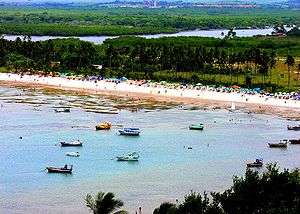Cabo de Santo Agostinho

Cabo de Santo Agostinho (Cape of Saint Augustine) is 35 km south of the city of Recife, Pernambuco, Brazil. Although the official Portuguese discovery of Brazil was by Pedro Álvares Cabral on April 21, 1500, some historians believe that Vicente Yáñez Pinzón already had set anchor in a bay in Cabo de Santo Agostinho on January 26, 1500, which he named Cabo de Santa María de la Consolación.[1] It was incorporated as a town in 1811.
Cabo de Santo Agostinho has both an industrial section that is centered on the Suape port and many tropical beaches and nature reserves. The best known beaches are Calhetas, Paraíso, and Gaibu. In Pedra do Xareu one can find the Recanto do Domingos at the far south end of the beach. Accommodations at beaches can range from inexpensive pousadas (bed and breakfast) to extremely expensive resorts.
Geography
- State: Pernambuco
- Region: RMR (Recife)
- Boundaries: Jaboatão dos Guararapes, Moreno, Pernambuco (N), Ipojuca, Escada (S), Vitória de Santo Antão (W) and Atlantic ocean (E)
- Area: 447.88 km2
- Elevation: 29 m
- Hidrography: small coast rivers
- Beaches: Gaibu, Enseada dos corais, Calhetas, Paraiso and Pedra do Xareu
- Vegetation: Atlantic forest, Capoeirinha, Coconut trees, sugarcane plantation and Manguezais
- Clima: Hot tropical and humid
- Annual average temperature: 25.2° C
- Main road: BR 101
- Distance to Recife: 35 km
Economy
The main economic activities in Cabo de Santo Agostinho are based in tourism, commerce and a strong and diversified industry located close to Suape port.
Economic indicators
| Population [2] | GDP x(1000 R$).[3] | GDP pc (R$) | PE | RMR |
|---|---|---|---|---|
| 171.583 | 2.813.188 | 17.244 | 4.60% | 7.16% |
| Primary sector | Secondary sector | Service sector |
|---|---|---|
| 0.57% | 59.94% | 39.49% |
Suape Harbour
Suape port is an international port located in the city of Ipojuca in the state of Pernambuco, among the municipalities of Ipojuca and Cabo de Santo Agostinho, inside the Recife metropolitan area and distant 40 km south of the capital (Recife). Suape serves ships 365 days a year without any restriction with regard to tidal schedules. Suape is one of the most important harbour and container terminals in northeast Brazil playing an important role in the economy of the state of Pernambuco.[4] Suape has started in the 21st century to be Pernambuco's motive power toward development. Huge national and international investments are being attracted by its logistic qualities, of which, until 2010, more than US$10 billion are expected.
Health indicators
| HDI (2000) | Hospitals (2007) | Hospitals beds (2007) | Children's mortality per 1000 (2005) |
|---|---|---|---|
| 0.707 | 4 | 281 | 15.9 |
Beaches

- Paiva beach
- Much sought for the practice of surf, has warm and transparent water, vegetation of Atlantic forest and coconut trees, and small natural pools formed between the rocks. Does not provide any visitors service yet. There is a mall, a huge hotel and all a new neighborhood been built in there.
- Itapuama beach
- With two kilometers long, is a hot site for water sports and fishing. Has hotels, bars and restaurants.
- Xeréu beach
- Due to the depth of the water, this beach is suitable for diving and also for fishing. In the sand, has volcanic rocks and the bather has access to tents where is served appetizers and fish meals.
- Enseada dos Corais beach
- Means coral bay, it has natural reefs and weak waves. The services are just a few bars and restaurants.
- Gaibu beach
- High waves and wide range of sand in its 3-kilometer length. Good for swimming but it requires attention because of the existence of deep areas. At high tides is good for surfing. It has several hotels, hostels, bars, restaurants, etc. Together, with Porto de Galinhas and Itamaracá beaches are part of the most exciting beaches in the Northeast coast of Brazil.
- Calhetas
- Much sought for diving, is stuck between rocks and coconut trees. It has bars and restaurants and, is one of the hot spots of the state for underwater fishing.
- Paraiso beach
- The name means heaven, it is a tiny beach (little heaven) about 30 meters long and stuck between large rocks. The reefs make the sea almost without waves and that is the reason of the name.
- Suape beach
- Virtually without waves and little deep sea, is considered excellent for water sports. At low tide, there are sand banks. It is located in the Suape region close to the industrial and port complex of Suape.
Notes and references
- ↑ Morison, Samuel (1974). The European Discovery of America: The Southern Voyages, 1492–1616. New York: Oxford University Press.
- ↑ http://www.ibge.gov.br/home/estatistica/populacao/estimativa2009/POP2009_DOU.pdf IBGE Population 2009 Cabo de Santo Agostinho, page 32]
- ↑ Cabo de Santo Agostinho 2007 GDP IBGE page 29 Archived March 4, 2016, at the Wayback Machine.
- ↑ SUAPE - Port and Industrial Complex
- ↑ PE State site - City by city profile